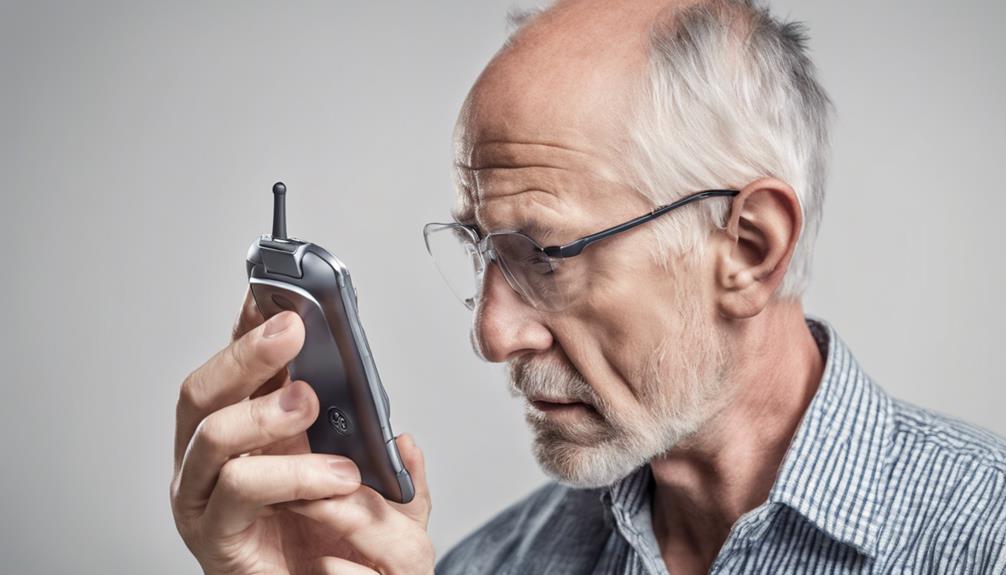In the field of auditory processing therapy, setting goals is similar to plotting a course through a vast ocean – precise navigation is essential to reach the desired outcome.
As we navigate the complexities of auditory processing challenges, understanding how to establish effective and measurable goals becomes paramount.
By unraveling the intricacies of this step-by-step guide, we uncover the blueprint for optimizing therapeutic outcomes and fostering growth in individuals with auditory processing difficulties.
Join us as we explore the practical strategies and methodologies that pave the way for meaningful progress and success in this crucial area of speech therapy.
Key Takeaways
- Establish specific, measurable goals for auditory processing challenges.
- Break down goals into manageable steps for effective progress tracking.
- Utilize tailored strategies to enhance auditory skill development.
- Regularly monitor and assess progress towards achieving set goals.
Understanding Auditory Processing Disorder
Understanding Auditory Processing Disorder involves delving into how sound processing in the brain is impacted, leading to challenges in interpreting auditory information. Individuals with Auditory Processing Disorder (APD) struggle to make sense of the sounds they hear, affecting their ability to understand speech, follow directions, and engage in conversations.
This can result in difficulties in academic settings, social interactions, and everyday communication tasks. Diagnosis of APD is intricate, requiring evaluations by audiologists, psychologists, and speech-language therapists to assess auditory processing abilities comprehensively.
Treatment for APD focuses on utilizing compensatory strategies and accommodations tailored to the individual's specific challenges, rather than relying on medication. Support strategies play a vital role in helping individuals with APD navigate their auditory processing difficulties effectively, fostering improved communication and learning outcomes.
Understanding the intricacies of APD is fundamental in developing targeted interventions and support plans that cater to the unique needs of individuals grappling with this disorder.
Identifying Symptoms and Behaviors

Identifying Symptoms and Behaviors associated with Auditory Processing Disorder (APD) is crucial in recognizing the challenges individuals may face in processing auditory information effectively. Symptoms of APD can present in various ways, such as difficulty following spoken instructions, especially in noisy environments, and challenges understanding speech clearly. On the other hand, behaviors linked to APD include requesting repetition of information, misinterpreting directions, and struggling with phonological processing. Children with APD may experience delays in speech and language development, ultimately impacting their academic performance.
To further highlight the symptoms and behaviors associated with APD, the table below outlines some common signs that individuals with APD may exhibit:
| Symptoms | Behaviors |
|---|---|
| Difficulty following instructions | Requesting repetition of information |
| Challenges in noisy environments | Misinterpreting directions |
| Trouble understanding speech clearly | Struggling with phonological processing |
| Delays in speech and language development | Frustration during conversations |
These signs can manifest as poor listening skills, difficulty distinguishing speech sounds, and challenges concentrating in noisy settings, affecting not only academic performance but also social interactions. Identifying these symptoms and behaviors is essential for speech therapists to establish effective goals and interventions to support individuals with auditory processing difficulties.
Diagnosing Auditory Processing Challenges
In diagnosing auditory processing challenges, we rely on a multidisciplinary approach involving audiologists, speech-language pathologists, and other experts.
Comprehensive evaluations assess auditory discrimination, binaural processing, and temporal abilities to pinpoint specific deficits.
Through behavioral observations, standardized tests, and input from parents/teachers, we ensure accurate diagnosis essential for tailored interventions.
Symptoms of Auditory Processing
When evaluating auditory processing challenges, clinicians observe how individuals respond to verbal instructions and process information in various auditory environments. Symptoms of auditory processing challenges in children may include:
- Difficulty following verbal directions accurately, leading to misunderstandings.
- Struggles with phonological awareness, affecting reading and spelling skills.
- Problems with speech discrimination, impacting the ability to distinguish sounds.
- Auditory memory issues, resulting in forgetfulness of spoken information.
These challenges can manifest as delayed language development, academic difficulties, and social communication struggles. Diagnosing auditory processing difficulties requires comprehensive evaluations by audiologists, speech-language pathologists, and other professionals to pinpoint specific deficits accurately.
Assessment Tools Available
Our evaluation process for auditory processing challenges involves utilizing a range of specialized assessment tools to provide a comprehensive understanding of an individual's auditory processing abilities. Standardized tests like the SCAN-3: C and the APD Profile help in diagnosing auditory processing challenges.
Behavioral observation tools such as the APD Behavior Rating Inventory of Executive Function aid in understanding difficulties. Electrophysiological tests like the Auditory Brainstem Response (ABR) provide objective data.
Speech perception tests, including the Gaps-In-Noise (GIN) test, assess temporal processing deficits. Multi-disciplinary evaluations with audiologists, speech-language pathologists, and psychologists are crucial for a thorough assessment of auditory processing issues.
These tools collectively offer insights that guide the development of targeted interventions for individuals experiencing auditory processing challenges.
Treatment Options Overview
Utilizing evidence-based approaches, professionals employ a range of interventions to address auditory processing challenges diagnosed through comprehensive evaluations by pediatric audiologists and speech-language therapists.
When considering treatment options for auditory processing difficulties, four key strategies are commonly implemented:
- Auditory Training Programs: These programs aim to improve auditory discrimination and processing speed through targeted exercises.
- Environmental Modifications: Adjustments in the learning or living environment to reduce background noise and enhance the clarity of auditory stimuli.
- Speech Therapy: Targeted interventions focusing on improving speech sound discrimination and language processing skills.
- Assistive Technology: Devices such as FM systems or noise-canceling headphones can help individuals better access and understand auditory information.
These interventions play a crucial role in addressing the challenges faced by individuals with auditory processing difficulties.
Importance of Setting Goals

Setting specific and measurable goals in auditory processing speech therapy serves as a fundamental cornerstone for effective intervention strategies. Goals play a vital role in guiding therapists, educators, and parents in designing targeted interventions to address auditory processing challenges in students.
By setting clear goals, progress tracking becomes more manageable, enabling adjustments to therapy techniques for optimal outcomes. These goals provide a roadmap for addressing specific auditory processing difficulties and improving listening skills collaboratively. Collaboration among all stakeholders is essential to ensure that goals are realistic and achievable, supporting students with auditory processing issues effectively.
Clear goals empower the therapy team to work towards a common objective, enhancing the overall effectiveness of the intervention. In essence, the importance of setting goals in auditory processing speech therapy can't be overstated as it forms the foundation for tailored and impactful interventions aimed at improving students' auditory processing abilities.
Defining Measurable Objectives

To ensure effective intervention strategies in auditory processing speech therapy, it's essential to define measurable objectives that serve as specific, quantifiable targets for skill improvement.
When defining measurable objectives in auditory processing speech therapy, several key aspects need to be considered:
- Specificity: Objectives should be clearly defined to address particular areas of auditory processing challenges.
- Measurability: Each objective should be quantifiable so that progress can be tracked over time accurately.
- Alignment: Objectives must align with the individual's needs and abilities to ensure relevance and attainability.
- Observability: Defined objectives should be observable, allowing therapists to monitor and evaluate progress effectively.
Strategies for Goal Setting

Incorporating evidence-based practices and tailored interventions is crucial when strategizing goal setting for auditory processing speech therapy. To ensure effective goal setting, it is essential to follow the SMART goals framework, which emphasizes creating goals that are Specific, Measurable, Achievable, Relevant, and Time-bound. Breaking down these goals into smaller steps can make them more manageable and aid in tracking progress effectively. Regularly monitoring progress allows for adjustments to be made as needed, ensuring that goals remain relevant and effective. Flexibility in goal setting is key to addressing the evolving challenges that may arise during auditory processing speech therapy sessions. By incorporating evidence-based practices and interventions tailored to the individual's auditory processing needs, speech therapists can optimize the effectiveness of their therapy sessions.
| Strategies for Goal Setting | Description |
|---|---|
| SMART goals | Create specific, measurable, achievable, relevant, and time-bound goals. |
| Break down goals | Divide goals into smaller steps to enhance manageability and progress tracking. |
| Evidence-based practices | Utilize interventions supported by research and tailored to individual needs. |
| Monitoring progress | Regularly track progress and make adjustments to ensure goal relevance and effectiveness. |
| Flexibility in goal setting | Remain adaptable to address evolving auditory processing challenges effectively. |
Addressing Learning Challenges

When addressing learning challenges in speech therapy for auditory processing, we focus on implementing tailored learning strategies to enhance skill development.
By identifying specific areas of difficulty, we can create targeted goals to improve academic and social performance.
Evidence-based interventions and consistent monitoring of progress play key roles in optimizing therapeutic outcomes.
Learning Strategies
Implementing multisensory learning techniques benefits students with auditory processing challenges by enhancing comprehension through the use of visual aids and written instructions alongside verbal cues. When addressing learning challenges, it's crucial to tailor teaching strategies to individual learning styles. Here are some effective learning strategies for students with auditory processing issues:
- Providing a variety of visual aids such as charts, diagrams, and illustrations.
- Offering written instructions to complement verbal information.
- Engaging students in interactive activities like role-playing or hands-on experiments.
- Collaborating with educators, speech-language therapists, and audiologists to develop personalized learning plans.
Skill Development
To address learning challenges in auditory processing, setting specific goals tailored to individual needs is essential for skill development. These goals should target enhancing auditory discrimination, binaural processing, and temporal processing skills.
Speech therapy goals play a crucial role in improving comprehension, communication, and academic performance. Monitoring progress in skill development requires establishing measurable benchmarks and conducting regular assessments.
Skill development goals must be achievable, relevant, and time-bound to effectively track improvement. By focusing on these key areas and implementing targeted interventions, individuals can make significant strides in their auditory processing abilities.
Through a structured approach that emphasizes skill enhancement, individuals can work towards overcoming learning challenges and achieving their full potential in auditory processing.
Interventions and Therapies

Speech therapy interventions for auditory processing focus on enhancing auditory discrimination, binaural processing, and temporal processing skills to address communication challenges.
Here are some key interventions and therapies utilized in speech therapy for auditory processing:
- Auditory Discrimination Activities: These activities help individuals distinguish between similar sounds to improve their ability to recognize speech accurately.
- Binaural Processing Exercises: Techniques that target the brain's ability to integrate information from both ears, aiding in better sound localization and auditory scene analysis.
- Temporal Processing Training: Therapy exercises that focus on improving the processing speed of auditory information, crucial for understanding speech in real-time conversations.
- Compensatory Strategies: Teaching individuals strategies to cope with auditory processing difficulties, such as using visual cues or requesting repetition when needed.
Utilizing Speech Therapy Tools

Utilizing innovative tools in speech therapy enhances the effectiveness of interventions aimed at improving auditory processing skills. Speech therapy tools encompass a range of software programs, apps, and interactive games specifically designed to target areas such as auditory discrimination, auditory memory, and auditory sequencing. These tools are equipped with visual aids and feedback mechanisms that play a crucial role in reinforcing learning, enhancing engagement, and providing real-time feedback during therapy sessions. By customizing speech therapy tools to individual needs and progress, personalized interventions can be developed to address unique auditory processing challenges effectively.
The integration of speech therapy tools alongside traditional therapy methods not only amplifies outcomes but also supports sustained progress in auditory processing over the long term. Through the utilization of these tools, individuals can actively engage in listening exercises, receive targeted auditory discrimination tasks, and benefit from immediate feedback mechanisms that facilitate skill development and retention.
Classroom Accommodations

Incorporating appropriate classroom accommodations plays a crucial role in supporting students with auditory processing difficulties to effectively engage in academic tasks and optimize learning outcomes. When considering accommodations for students with auditory processing challenges, several strategies can be implemented to create a conducive learning environment:
- Preferential Seating: Placing the student near the teacher can minimize distractions and facilitate better communication during lessons.
- Noise-canceling Headphones: Providing these can help reduce auditory overload, allowing the student to focus better on the task at hand.
- Extended Task Time: Allowing additional time for assignments can support students in processing auditory information and completing tasks effectively.
- Visual Aids: Incorporating charts, diagrams, and illustrations alongside verbal instructions can enhance comprehension and aid in achieving academic success.
Collaborating with teachers and school staff to tailor these accommodations to the student's specific auditory processing needs is essential for promoting their academic success. By implementing these strategies, students can better navigate the classroom environment and achieve their educational goals.
Tracking Progress and Adjustments

When monitoring progress in auditory processing therapy, it's crucial to track specific benchmarks related to the student's skills and make adjustments based on regular assessments. Data collection plays a vital role in identifying areas for improvement and those requiring further intervention.
By consistently tracking progress, we ensure that therapy goals remain relevant and achievable for the student. Regular assessments are essential for gauging the effectiveness of the current therapy plan and determining if modifications are necessary to optimize progress in auditory processing skills.
These assessments provide valuable insights into the student's response to therapy, guiding us in making informed adjustments. Progress tracking allows us to measure the success of interventions and tailor the therapy plan to meet the student's evolving needs.
Through diligent data collection and analysis, we can enhance the student's auditory processing abilities effectively and efficiently.
Enhancing Auditory Processing Skills

As we explore enhancing auditory processing skills, we'll focus on specific points to aid in skill development.
Effective listening techniques play a crucial role in improving auditory discrimination and sound localization abilities.
Enhancing these skills ultimately leads to improved communication abilities essential for various aspects of daily life.
Skill Development Strategies
To enhance auditory processing skills, auditory discrimination activities such as identifying similar sounds can be utilized effectively. Here are some skill development strategies:
- Binaural Processing: Engage in exercises that involve locating sounds from different directions to improve spatial awareness.
- Temporal Processing: Practice tasks that require sequencing auditory stimuli for better comprehension and memory.
- Auditory Closure: Utilize exercises where partial auditory information is provided to enhance listening skills.
- Auditory Memory: Engage in activities that involve recalling sequences of sounds to strengthen memory retention.
Effective Listening Techniques
Effective listening techniques play a crucial role in enhancing auditory processing skills, particularly for individuals with Auditory Processing Disorder (APD) or Central Auditory Processing Disorder (CAPD). Active listening strategies, like maintaining eye contact and summarizing information, can boost comprehension for those facing auditory processing challenges. Visual aids, gestures, and repetition are beneficial for auditory learners, aiding in processing and retaining spoken information.
Focused listening, achieved by reducing distractions and offering clear instructions, optimizes auditory processing abilities. Multisensory approaches, combining auditory input with visual or tactile cues, improve understanding and memory retention for individuals struggling with auditory processing. By incorporating these techniques, individuals with APD or CAPD can overcome their auditory processing challenges and enhance their overall communication skills.
Improving Communication Abilities
Improving communication abilities through enhancing auditory processing skills involves honing the brain's capacity to accurately interpret and understand sounds. As we delve into this area, we focus on specific aspects of auditory processing to enhance spoken language comprehension and overall communication skills.
Effective strategies target auditory discrimination, auditory memory, auditory sequencing, and sound localization. By addressing processing speed, individuals can improve their ability to process information quickly and efficiently, leading to better communication outcomes.
Progress in auditory processing can have far-reaching benefits, impacting academic performance, social interactions, and overall quality of life. It's through these targeted exercises and goals that individuals can unlock their full potential in the realm of communication and auditory processing.
Frequently Asked Questions
What Are the IEP Goals for Auditory Comprehension?
We focus on enhancing auditory comprehension in IEP goals to improve understanding of spoken language and following verbal instructions. Objectives include recalling and comprehending orally presented information, improving listening skills in various environments, and distinguishing similar sounds.
Progress is measured through assessments, observations, and feedback. These goals support academic success, social interactions, and communication skills, aiming to empower individuals in their learning and daily interactions.
What Are the Steps in the Auditory Processing Hierarchy?
We progress through the auditory processing hierarchy by mastering acoustic, phonologic, linguistic, and cognitive-communicative skills. Each level impacts academic and social success.
Collaboration between audiologists and speech-language pathologists is crucial to assess and address deficits effectively. Understanding this hierarchy is key to developing precise intervention strategies.
Building foundational skills is essential for higher-level auditory processing, leading to improved communication abilities and overall quality of life.
How Do You Target Auditory Processing?
When targeting auditory processing, we focus on improving how the brain interprets and responds to sounds. Strategies include exercises to enhance discrimination between different sounds, processing information from both ears simultaneously, and understanding the timing of sounds.
How Do You Write a Goal for Speech Therapy?
When writing a goal for speech therapy, we consider the individual's needs and tailor goals to be specific, measurable, achievable, relevant, and time-bound (SMART).
Collaboration with speech-language pathologists helps establish goals that address auditory processing deficits effectively.
Regular monitoring and adjustments are crucial for tracking progress.
Conclusion
In conclusion, setting auditory processing speech therapy goals is essential for individuals with auditory processing challenges. By utilizing evidence-based practices and the SMART framework, therapy activities can effectively improve core auditory perceptual skills.
Collaborating with professionals to tailor interventions and track progress is crucial for achieving measurable objectives. Ultimately, these efforts can lead to a significant transformation in communication abilities, creating a world of sound that's as vivid and clear as a symphony in full bloom.











